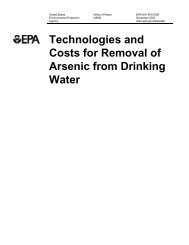Rainwater harvesting in India - Harvard University Department of ...
Rainwater harvesting in India - Harvard University Department of ...
Rainwater harvesting in India - Harvard University Department of ...
You also want an ePaper? Increase the reach of your titles
YUMPU automatically turns print PDFs into web optimized ePapers that Google loves.
Comment by Meera M Hira Smith January 18, 2006(http://www.projectwellusa.org/)The declaration at the end <strong>of</strong> the conference held at the Dhaka Community Hospital onthe 4 th January 2006 organized by DCH and School <strong>of</strong> Environmental Studies, SOESemphasized on ra<strong>in</strong>water <strong>harvest<strong>in</strong>g</strong> and surface water as sources <strong>of</strong> arsenic safe dr<strong>in</strong>k<strong>in</strong>gwater. There are several types <strong>of</strong> ra<strong>in</strong>water <strong>harvest<strong>in</strong>g</strong>. Some <strong>of</strong> the types practised <strong>in</strong><strong>India</strong> are available at this web l<strong>in</strong>k ……<strong>Ra<strong>in</strong>water</strong> <strong>harvest<strong>in</strong>g</strong> <strong>in</strong> Argent<strong>in</strong>a is practiced <strong>in</strong> the rural areas where the ro<strong>of</strong>tops areconcrete and flat and water is collected and stored <strong>in</strong> an underground reservoir bigenough to store water for the whole year. As dis<strong>in</strong>fectant Clorox (regular bleach<strong>in</strong>gpowder) is applied twice a year and the tank is cleaned once a year (picture1). There arevarious ways <strong>of</strong> collect<strong>in</strong>g clean water from the ro<strong>of</strong>top. Picture 2 shows unclean watergoes down the dra<strong>in</strong> where the down pipe is positioned and as the water is observed asclear <strong>in</strong> a glass tumbler the pipe is positioned to the second dra<strong>in</strong> that is connected to thereservoir.Picture 1 Picture 2In Bangladesh how many houses have such concrete ro<strong>of</strong>? What about the poor who live<strong>in</strong> the houses made <strong>of</strong> thatched ro<strong>of</strong>?Large scale ra<strong>in</strong>water <strong>harvest<strong>in</strong>g</strong> can be executed by build<strong>in</strong>g concrete reservoirs thatrequire a considerable amount <strong>of</strong> construction cost followed by ma<strong>in</strong>tenance expenditure.Its operation would be successful if the government or local NGO regularly ma<strong>in</strong>ta<strong>in</strong>s itvia rural water supply boards. Formation <strong>of</strong> cooperatives and expect<strong>in</strong>g the local ruralpeople <strong>in</strong> groups, to ma<strong>in</strong>ta<strong>in</strong> each project would NOT be a practical approach unless thegroups are fairly small.
Where as the ‘chulli’ system 1 , discussed at the conference by Pr<strong>of</strong>. Mohammad FakhrulIslam <strong>of</strong> Rajshahi <strong>University</strong>, would be a pragmatic approach because every family, eventhe poorest <strong>of</strong> poor, cook at least a pot <strong>of</strong> rice each day. Hence there is no question <strong>of</strong>extra expense on monthly basis. If the raw water is CLEAR the villagers would gladlyaccept the ‘chulli’ system. Hand pumps, draw<strong>in</strong>g water out from dugwell, pond, river orstream would provide clear water because <strong>of</strong> the filter that is attached to the receiv<strong>in</strong>g end<strong>of</strong> the pipe that delivers water.It is true that any one option is not suitable throughout the region but one should opt forthe cheapest method that require least ma<strong>in</strong>tenance to fit <strong>in</strong>to the socio-economicbackground <strong>of</strong> the region. Where community dugwells are suitable ra<strong>in</strong>water <strong>harvest<strong>in</strong>g</strong>may not be required because properly constructed dugwells ma<strong>in</strong>ta<strong>in</strong>ed by a smallnumber <strong>of</strong> families is feasible that requires use <strong>of</strong> chlor<strong>in</strong>e once a month to control thebacterial growth or better still if the dugwell water can be passed through the ‘chulli’system to avoid use <strong>of</strong> any dis<strong>in</strong>fectant. However, more observation would be advisableon the efficacy <strong>of</strong> the chulli system and the growth <strong>of</strong> bacteria, if any, due to poorsanitation and hygiene practice that is common to all the options. Hence door-to-doorpublic education on arsenic related illnesses and on practice <strong>of</strong> personal hygiene isessential and demands highest priority.Lets hope for the best.Any comments and/or queries may be directed to mmhsmith@berkeley.eduThank You.1 ‘Chulli’ system is pass<strong>in</strong>g raw water through alum<strong>in</strong>um pipe/coil embedded <strong>in</strong> the clay ovens, ‘chullis’designed to kill bacteria by shock treatment with high temperature.
















